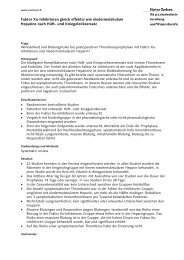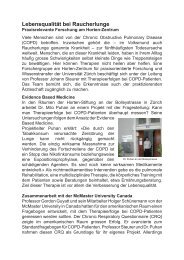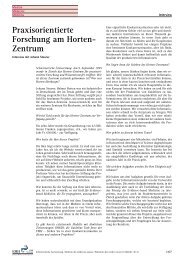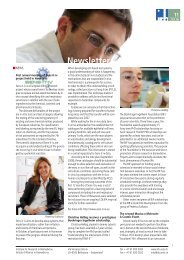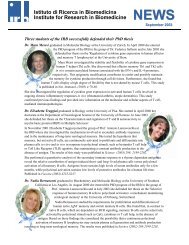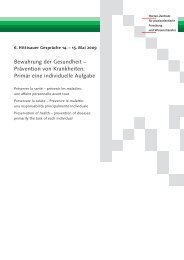Annals of Internal Medicine - Helmut Horten Stiftung
Annals of Internal Medicine - Helmut Horten Stiftung
Annals of Internal Medicine - Helmut Horten Stiftung
You also want an ePaper? Increase the reach of your titles
YUMPU automatically turns print PDFs into web optimized ePapers that Google loves.
Article Interval Exercise for Patients with Chronic Obstructive Pulmonary Disease<br />
Table 1. Baseline Characteristics<br />
Characteristic Interval<br />
Exercise<br />
Group<br />
(n � 48)<br />
Continuous<br />
Exercise<br />
Group<br />
(n � 50)<br />
Age, y 69.0 (9.2) 68.9 (9.2)<br />
Male, % 29 (60.4) 36 (72.0)<br />
FEV 1, L 0.87 (0.27) 0.89 (0.29)<br />
FEV 1, % predicted 34.5 (9.0) 34.1 (8.0)<br />
Mean FEV 1/FVC (SD)* 0.49 (0.19) 0.47 (0.21)<br />
Exacerbation within last 8 wk, % 29 (60.4) 30 (60.0)<br />
PaO 2, mm Hg 57.1 (8.9) 59.5 (9.7)<br />
Mean y since diagnosis (SD)* 9.4 (8.4) 9.2 (6.6)<br />
Mean pack y (SD)† 51.4 (31.4) 54.1 (28.3)<br />
Smoking, % 3 (6.3) 6 (12.0)<br />
Mean body mass index (SD)† 25.4 (6.9) 24.0 (5.8)<br />
Chronic Respiratory Questionnaire<br />
Dyspnea 2.83 (0.90) 3.03 (1.05)<br />
Fatigue 3.63 (1.15) 3.92 (1.28)<br />
Emotional function 3.95 (1.20) 4.12 (1.24)<br />
Mastery 4.03 (1.31) 4.16 (1.34)<br />
Total score 3.61 (0.98) 3.81 (0.98)<br />
Feeling thermometer 53.1 (17.9) 52.9 (18.7)<br />
Hospital Anxiety and Depression Scale<br />
Depression domain 7.71 (4.03) 7.45 (3.91)<br />
Anxiety domain 7.13 (3.64) 6.81 (4.36)<br />
6-min walking distance, m 312.8 (107.9) 332.4 (116.0)<br />
Short-time maximum exercise capacity, W 106.3 (48.8) 119.6 (53.5)<br />
Maximum exercise capacity, W 53.2 (26.5) 50.6 (19.0)<br />
Medication, %<br />
Short-acting �-agonist 37 (77.1) 37 (74.0)<br />
Long short-acting �-agonist 44 (91.7) 43 (86.0)<br />
Anticholinergic bronchodilators 26 (54.2) 28 (56.0)<br />
Inhaled steroid 38 (79.2) 39 (78.0)<br />
Oral steroid 27 (56.3) 21 (42.0)<br />
Theophylline 8 (16.7) 7 (14.0)<br />
Antibiotics 12 (25.0) 4 (8.0)<br />
Anabolic steroid 2 (4.2) 1 (2.0)<br />
Comorbid conditions, %<br />
Cardiovascular 25 (52.1) 32 (64.0)<br />
Endocrine 13 (27.1) 8 (16.0)<br />
Musculoskeletal 7 (14.6) 6 (12.0)<br />
* Data missing for 6 patients (2 in interval and 4 in continuous exercise group).<br />
† Data missing for 3 patients (1 in interval and 2 in continuous exercise group).<br />
Finally, we analyzed exercise tolerance by comparing<br />
the number <strong>of</strong> breaks between groups using the Mann–<br />
Whitney U test and the proportion <strong>of</strong> patients achieving<br />
target exercise using the chi-square test.<br />
We handled missing data as follows: If CRQ data were<br />
not available at 5-week follow-up, we carried forward the<br />
CRQ data from the 3-week follow-up assessment at the<br />
end <strong>of</strong> the inpatient rehabilitation. Data were missing for 6<br />
patients using interval exercise (all were included in per<br />
protocol and intention-to-treat analyses) and for 4 patients<br />
using continuous exercise (2 were included in the per protocol<br />
analysis, and all 4 were included in the intention-totreat<br />
analysis). We did not impute any data if neither the<br />
3-week nor the 5-week assessments were available. The per<br />
protocol and intention-to-treat analyses were based on patients<br />
with follow-up data. Four patients (2 from each<br />
group) had no follow-up data and were excluded from all<br />
analyses. In addition, for the per protocol analyses, 1, 1, 2,<br />
and 9 patients had missing CRQ, 6-minute walking distance,<br />
maximum exercise capacity, and short-term maximum<br />
exercise capacity data, respectively. For the intentionto-treat<br />
analyses, in addition to the 4 patients without<br />
follow-up data, 4, 5, 7, and 13 patients had missing CRQ,<br />
6-minute walking distance, maximum exercise capacity,<br />
and short-term maximum exercise capacity data, respectively.<br />
We conducted a sensitivity analysis <strong>of</strong> the per protocol<br />
analysis to test our method <strong>of</strong> carrying forward CRQ scores<br />
from the 3-week assessment to follow-up after 5 weeks for<br />
patients with missing values (n � 8). We used several imputations<br />
with chained equations to predict CRQ total<br />
scores after 5 weeks based on available data and repeated<br />
the adjusted between-group comparisons (ice and micombine<br />
commands <strong>of</strong> STATA for Windows 8.2, College Station,<br />
Texas).<br />
For data on exercise tolerance (breaks and adherence<br />
to protocol), physiotherapists completed all exercise protocols.<br />
We had computerized recordings for 44 patients using<br />
interval exercise and 50 patients using continuous exercise.<br />
We determined that a sample size <strong>of</strong> 44 patients in<br />
each group would show the noninferiority <strong>of</strong> interval exercise,<br />
assuming noninferiority margins <strong>of</strong> 0.5 in CRQ scores<br />
and 45 meters in 6-minute walking distance between<br />
groups, with 90% power at a significance level <strong>of</strong> 5% (1sided).<br />
With an assumed drop-out rate <strong>of</strong> 15%, the total<br />
sample size increased to 104 (23). After 30 participants<br />
were enrolled in each arm, we calculated the standard deviation<br />
<strong>of</strong> CRQ scores and found that data met our assumptions.<br />
However, we noticed fewer drop-outs than anticipated<br />
and, therefore, terminated recruitment after 100<br />
patients. We performed all analyses using SPSS, version<br />
12.0.1 (SPSS, Inc., Chicago, Illinois).<br />
Role <strong>of</strong> the Funding Sources<br />
AstraZeneca Switzerland, Boehringer Ingelheim Switzerland,<br />
and the Klinik Barmelweid provided unrestricted<br />
grants for this trial. These funding sources did not have<br />
any influence on the planning, conduct, analyses, or publication<br />
<strong>of</strong> the trial or its results.<br />
RESULTS<br />
Between May 2004 and November 2005, 100 <strong>of</strong> 103<br />
eligible patients agreed to participate in this study (Figure<br />
2). One patient in each group withdrew informed consent<br />
for unspecified reasons. Forty-three (89.6%) and 44<br />
(88.0%) patients completed the inpatient rehabilitation in<br />
the interval and continuous exercise groups, respectively.<br />
Eleven patients did not complete the rehabilitation because<br />
<strong>of</strong> COPD exacerbations (3 patients in the interval and 2<br />
patients in the continuous exercise group); musculoskeletal<br />
pain (2 patients in the interval and 1 patient in the continuous<br />
exercise group); and, in the continuous exercise<br />
820 5 December 2006 <strong>Annals</strong> <strong>of</strong> <strong>Internal</strong> <strong>Medicine</strong> Volume 145 Number 11 www.annals.org



